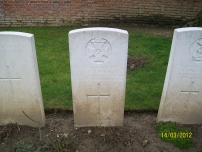| First Name: | Frederick | Last Name: | WEEDON | |
|---|---|---|---|---|
| Date of Death: | 03/09/1916 | Lived/Born In: | Harrow Road | |
| Rank: | Sergeant | Unit: | King's Royal Rifle Corps17 | |
| Memorial Site: | ||||
Current Information:Age-26 58, Torquay Street, Harrow Road Ancre British Cemetery, Beaumont-Hamel, Somme
The Battle of the Somme (July-November, 1916) By the beginning of September, 1916, the Battle of the Somme had been raging for two months. Thousands of men had already been killed or wounded or were simply missing, never to be seen again and and just a few square miles of the French countryside, all in the southern part of the battlefield, had been captured from the enemy. Mistakes had been made by the various commanders and would be continued to be made but there was no turning back as the British, Australians, South Africans, New Zealanders and Canadians carried on battering away at the German defences in the hope of a breakthrough, So it continued all the way through to November with nearly every battalion and division then in France being drawn into it at some stage. In the end the German trenches had been pushed back a few more miles along most of the line but the cost in lives had been staggering. By the end of the fighting in November, 1916, British Army casualties numbered over 400,000, killed, wounded and missing. On 3rd September, 1916, the same day that the village of Guillemont finally fell to the British Army, there was another attack further north on the Somme battlefield, astride the River Ancre, a sector that had been largely inactive ever since the disasters of 1st July. 39th Division attacked along the north of the Ancre to secure a few hundred yards of high ground west-north-west of St Pierre-Divion in order to cover the flank of 49th Division attacking up the Ancre and to the south of it. Like so many other actions the British artillery barrage that preceded the attack left too much wire uncut and too many German machine gun nests and dug-outs intact. Add to this the power and the accuracy of the enemy artillery and the weak and exhausted state of the battalions involved and it becomes clear why the attack, despite great gallantry and repeated efforts, came to grief. 117 Brigade attacked on the left of 39th Division with 16th Rifle Brigade and 17th Sherwood Foresters. Zero hour was 5.10am and as soon as the attack commenced, two companies of 17th King’s Royal Rifle Corps, the support battalion of 117 Brigade, moved into the vacated front line trenches ready to join in the attack. At 8am, after receiving reports that 17th Sherwood Foresters had entered the German 1st line, these two companies set out across no-man’s-land to reinforce them. But by now the Germans were plastering both the British front line and no-man’s-land with their artillery and only a few made it safely across. During the morning there were further attempts to renew the attack but by the early afternoon a halt was called to proceedings and the survivors of all the battalions of 117 Brigade returned to their own lines. Nothing had been achieved except the deaths of many men. Although only in support, the casualties sustained by 17th King’s Royal Rifle Corps amounted to over 300 officers and men, one of whom was Frederick Weedon. |
||||
| « Back to Search Results | ||||
| If you think any of the information shown here is incorrect, Click Here to submit your amends and comments | ||||




